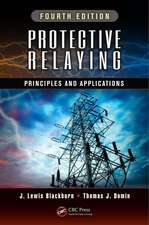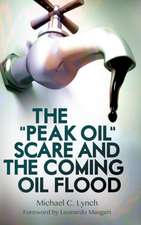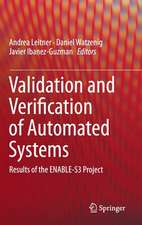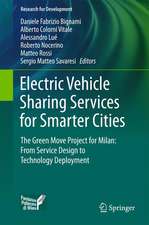Wind Energy: An Introduction
Autor Mohamed A. El-Sharkawien Limba Engleză Hardback – 10 iun 2015
- Explains the aerodynamic theories that govern the operation of wind turbines
- Presents wind energy statistics to address the stochastic nature of wind speed
- Employs the statistical modeling of wind speed to evaluate sites for wind energy generation
- Highlights the differences between the most common types of wind turbines
- Analyzes the main power electronic circuits used in wind energy
- Details the induction, synchronous, and permanent magnet generators from the basic principle of induced voltage to the steady-state and dynamic models
- Explores the operation, stability, control, and protection of type 1, 2, 3, and 4 wind turbines
- Discusses the main integration challenges of wind energy systems with electric utility systems
- Features numerous models, illustrations, real-world examples, and exercise problems
- Includes a solutions manual and figure slides with qualifying course adoption
Preț: 633.17 lei
Preț vechi: 843.78 lei
-25% Nou
Puncte Express: 950
Preț estimativ în valută:
121.17€ • 125.01$ • 102.55£
121.17€ • 125.01$ • 102.55£
Carte tipărită la comandă
Livrare economică 04-18 martie
Preluare comenzi: 021 569.72.76
Specificații
ISBN-13: 9781482263992
ISBN-10: 1482263998
Pagini: 355
Ilustrații: 27 black & white illustrations, 196 colour illustrations, 2 black & white tables
Dimensiuni: 178 x 254 x 20 mm
Greutate: 0.91 kg
Ediția:1
Editura: CRC Press
Colecția CRC Press
ISBN-10: 1482263998
Pagini: 355
Ilustrații: 27 black & white illustrations, 196 colour illustrations, 2 black & white tables
Dimensiuni: 178 x 254 x 20 mm
Greutate: 0.91 kg
Ediția:1
Editura: CRC Press
Colecția CRC Press
Cuprins
History of the Wind Energy Development. Aerodynamics of Wind Turbines. Wind Statistics. Overview of Wind Turbines. Solid-State Converters. Induction Generator. Synchronous Generator. Type 1 Wind Turbine System. Type 2 Wind Turbine System. Type 3 Wind Turbine System. Type 4 Wind Turbine. Grid Integration.
Notă biografică
Mohamed A. El-Sharkawi received his undergraduate education from Helwan University, Egypt, and his Ph.D from the University of British Columbia, Vancouver, Canada. He is currently professor of electrical engineering in the energy area at the University of Washington, Seattle, USA, where he has also served as the associate chair and the chairman of graduate studies and research. He has published more than 200 research articles, authored four textbooks, and co-authored three research books. An IEEE fellow, Professor El-Sharkawi has been the vice president for technical activities of the IEEE Computational Intelligence Society and the founding chairman of numerous IEEE task forces, working groups, and subcommittees. He holds five licensed patents related to renewable energy, VAR management, and minimum arc sequential circuit breaker switching.
Recenzii
"The book is an introduction to wind power, as the title indicates. El-Sharkawi (electrical engineering, Univ. of Washington, Seattle) presents the topic from a research and an industry point of view, with a lean toward electrical engineering aspects. Early chapters focus on the history of the technology, aerodynamics, and wind statistics (together forming the first fifth of the book). In following chapters, he discusses different types of converters, generators, wind turbine systems, and grid integration. The book reads easily, and benefits from a suitable number of (mostly color) figures, numerous worked-out examples, and end-of-chapter exercises. Although numerous books on wind power are already available (some very comprehensive), this work offers a relatively concise, well-organized resource; it would be an ideal textbook for undergraduate and graduate-level courses on wind energy. The book will be useful to advanced students and general readers interested in learning about the fundamentals of wind power. Readers need a basic knowledge of electrical engineering (at the undergraduate level) to gain the most from the text. Summing up: Recommended. Upper-level undergraduates through professionals/practitioners; two-year technical program students; informed general readers."
—M. Alam, University of California, Berkeley, USA, for CHOICE, March 2016
"Professor El-Sharkawi meets the growing demand from students and engineers interested in, or already working on, issues related to wind generation with a book covering all aspects of wind-power electrical engineering. As with his previous publications, El-Sharkawi succeeds in covering this important topic in great depth and clarity. The material is well presented following a logical development of the relevant topics. I would recommend this book to anyone interested in the subject of wind power generation."
—Izzy Kerszenbaum, IzzyTech Electrical Power Engineering Consulting & Training, Irvine, California, USA
"This book provides a rigorous introduction to the modeling and analysis of the power electronics at the heart of wind energy systems. It will serve as an essential component of modern energy curricula at the undergraduate and graduate levels."
—John O. Dabiri, California Institute of Technology, Pasadena, USA
"This book is well organized and covers many interesting topics related to grid integration of wind energy systems. It also covers key integration issues e.g. system stability, fault ride-through, variability of wind speed, and reactive power. This text book will be very useful to the engineering students as well as energy professionals."
—Prof. Mohan Kolhe, University of Agder (Norway)
—M. Alam, University of California, Berkeley, USA, for CHOICE, March 2016
"Professor El-Sharkawi meets the growing demand from students and engineers interested in, or already working on, issues related to wind generation with a book covering all aspects of wind-power electrical engineering. As with his previous publications, El-Sharkawi succeeds in covering this important topic in great depth and clarity. The material is well presented following a logical development of the relevant topics. I would recommend this book to anyone interested in the subject of wind power generation."
—Izzy Kerszenbaum, IzzyTech Electrical Power Engineering Consulting & Training, Irvine, California, USA
"This book provides a rigorous introduction to the modeling and analysis of the power electronics at the heart of wind energy systems. It will serve as an essential component of modern energy curricula at the undergraduate and graduate levels."
—John O. Dabiri, California Institute of Technology, Pasadena, USA
"This book is well organized and covers many interesting topics related to grid integration of wind energy systems. It also covers key integration issues e.g. system stability, fault ride-through, variability of wind speed, and reactive power. This text book will be very useful to the engineering students as well as energy professionals."
—Prof. Mohan Kolhe, University of Agder (Norway)
Descriere
This book covers wind energy system types, operation, modeling, analysis, integration, and control. Featuring numerous models, illustrations, examples, and exercises, the text explains the aerodynamic theories that govern the operation of wind turbines, highlights the differences between the most common types of wind turbines, analyzes the main power electronic circuits used in wind energy, details the electrical generators from the basic principle of induced voltage to the steady-state and dynamic models, and discusses the main integration challenges of wind energy systems with electric utility systems.























